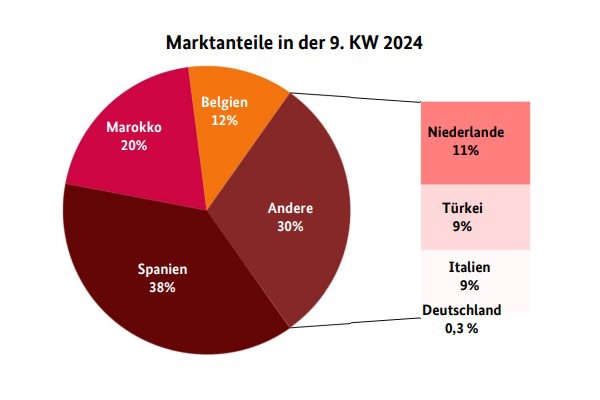A wide-ranging assortment remained available, with Spain, Morocco, Belgium, and the Netherlands playing the most significant roles. This was complemented by Turkish and Italian products. According to BLE, beefsteak tomatoes were primarily sourced from Spain and, to a lesser extent, Belgium. The ribbed beefsteak tomato Rebellion from Spain was offered in Frankfurt starting at €15 per 7-kg box and was eagerly purchased. Belgian counterparts had to reduce their initial price from €17 to about €15.50 per 7-kg box in Hamburg to remain competitive.
 © BLE
© BLE
Cherry tomatoes were predominantly from Italy, the Netherlands, and Spain. In the TOV segment, Spanish imports dominated, supplemented by extensive imports from Belgium and the Netherlands. Loose round products were mainly deliveries from Morocco and Spain, the former often exhibiting too pale a coloration. Also, in the tomato segment, Turkish product imports remained modest compared to the previous year, and in Munich, they weren't of the desired quality.
Apples
The week was characterized by a calm marketing atmosphere. Domestic batches formed the basis of the assortment as usual: Jonagold, Braeburn, and Tenroy gained in importance, while Elstar continued to lose relevance. Italy sent primarily products such as Pink Lady, Golden Delicious, Granny Smith, Jazz, and Kanzi, in addition to Tenroy.
Pears
In terms of quantity, South African imports took the lead, with steady supplies from Turkey and the Netherlands complementing the scene. South African Williams Christ, Rosemarie, and the newly arrived well-colored Cheeky and Abate Fetel were now noticeably increasing.
Table grapes
South African batches clearly dominated the market. Shipments from Peru and Namibia supplemented the scene. Small quantities of Indian batches appeared, but they only played a complementary role: Thompson Seedless cost €16 to €17 per 4.5-kg carton in Hamburg.
Oranges
For oranges, Spanish fruits were primarily available: Navelina, Nave Late, Lane Late, and Salustiana were mainly on offer. Among the Egyptian imports, Valencia Late increasingly replaced Navel. Due to the extensive arrivals from Egypt, their prices had to be corrected downwards.
Small citrus fruits
Despite the season slowly coming to an end, demand was not declining everywhere. Availability continued to restrict slightly, yet local interest remained stable. As a result, prices for the leading products solidified slightly.
Lemons
The range of the assortment was sufficiently harmonized with the storage possibilities. Spanish Primofiori dominated, followed in significance by Turkish Lama, which was now already complemented by the first Enterdonato.
Bananas
The week was marked by slow sales. Generally, supply and demand were sufficiently balanced so that evaluations did not change significantly. In Munich, the prices for all brands dropped slightly.
Cauliflower
French and Italian batches prevailed, supplemented by Spanish shipments. Interest was not particularly strong. Since availability had expanded, especially for French and Italian deliveries, targeted discounts could intensify demand.
Lettuces
Domestic butterhead and mixed salads from the greenhouse were offered on the South German wholesale markets. In Frankfurt, head lettuce was supposed to cost €8 per 6-pack, and red head lettuce in the 9-pack €12.50. Overall, Belgian and Italian offers predominated for head lettuces, complemented by domestic and French ones.
Cucumbers
Spanish cucumbers dominated the scene, with harvest volumes in the Netherlands and Belgium increasing and now gradually taking significant market share from the Spanish imports. Greek and newly introduced domestic offers locally complemented the market.
Bell peppers
Spanish shipments continued to prevail and were flanked by Turkish imports. Red offers from Morocco intensified in Frankfurt and Munich. Availability had expanded, with Spain currently harvesting and delivering at full speed.
Source: BLE
